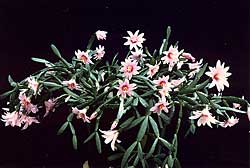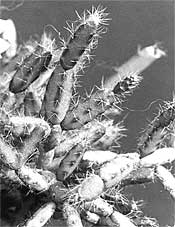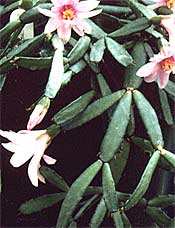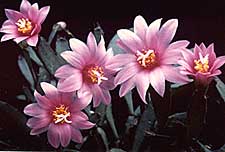Notes
RHIPSALIDOPSIS ROSEA (Rose Easter Cactus)
 Rejuvenating plant  Mature plant |
 Proto-phylloclades
|
 Phylloclades
|
Each very attractive rose-pink flower borne on this compact, nicely proportioned shrubby plant closes each evening during 7 to 10 days before it finally shrivels. Each opens to 4cm (1 and 3/4")
 diameter each morning, and all appear at the tips of the branches in April and early May. Generally, this season is somewhat cool, in Nova Scotia, and there is no artificial heat in my greenhouse at that time. The petals, true to the plant's popular name, are a delicate rose colour, shading to deeper rose-pink at the throat. The numerous yellow anthers, on deep pink filaments and the four or five white stigma lobes on their pink column complete the very beautiful colour scheme which, when the plant is in full bloom, present a sight for sore eyes! When fully in bloom, the very pleasant scent may be detected close to the plant, and it's well worth seeking it out.
diameter each morning, and all appear at the tips of the branches in April and early May. Generally, this season is somewhat cool, in Nova Scotia, and there is no artificial heat in my greenhouse at that time. The petals, true to the plant's popular name, are a delicate rose colour, shading to deeper rose-pink at the throat. The numerous yellow anthers, on deep pink filaments and the four or five white stigma lobes on their pink column complete the very beautiful colour scheme which, when the plant is in full bloom, present a sight for sore eyes! When fully in bloom, the very pleasant scent may be detected close to the plant, and it's well worth seeking it out.The rejuvenating plant at top, about 15cm (6") across and 10cm (4") tall, was about five years old, in a 8cm (3") standard pot. However, it had grown very slowly, in my collection, and was recovering from one of several losses of its branches caused by my initial ignorance of the special importance of proper irrigation. Nearly all of its visible phylloclades are of the juvenile, cereoid kind. It bloomed for the first time on mature segments in 1983 and gloriously each year thereafter with as many as 30 blooms open at once. Later, the plant reached nearly 25cm (10") diameter in a 13cm (5") pot (the mature plant at top). At that stage, a little improper watering, while I was unwell for a time, caused it to fall apart again, scattering phylloclades all around the pot. However, each piece was perfectly capable of rerooting itself, and all that I left on the soil surface started to do so within a week or two. The base stems also threw out new branches, not all of them showing the juvenile form mentioned above.
Culture
As an epiphyte, a 'Jungle Cactus', R. roseaneeds the same type of, but more careful, culture as Schlumbergera, the Christmas and Thanksgiving cacti. This calls for an organic, peat- or compost-based acidic soil about pH5.5 to pH6.0, which is never allowed to dry out completely nor to remain wet for long. Drainage must be excellent to promote aeration of the roots which cannot thrive without it. I like a mixture of two parts of sterile coarse compost or peat moss, and one part each of sterile garden soil and very coarse sand, preferred for its weight, or perlite. Acidity of the soil is important and should be maintained by studiously avoiding limed tap water which would eventually poison the plants, and using rain water, or treating tap water with two or three drops of nitric acid or 2ml to 5ml (1/2 to one tsp) of vinegar per 4.5 litres (gallon). As noted, both over- and under-watering are major causes of the plant shedding its phylloclades seemingly at the drop of a hat. It's a disappointing experience and very much worth avoiding! A little sunlight at dawn and at dusk is probably beneficial for Rose Easter Cactus but it is essential to avoid direct sunlight always at other times. Yet exposure to the northern sky overhead gives the best results.
I use a combination of 15-30-15 soluble fertilizer at 7ml (1/2tbsp) - instead of the (standard) recommended 15ml (tbsp) per 4.5L of water from about March or April at about 4 to 6 weeks intervals for two or three applications. Each is followed 2 or 3 weeks later by mild applications of 9-9-26 (Phostrogen) soluble fertilizer, 5ml (1 tsp) to 15 litres (3.5 gal.). This latter's extra potash enhances (deepens) the flower colours splendidly and it increases the likelihood of flowering at all of the branches. The high potash fertilizer may be applied throughout the feeding season from early April to about late June, and the last (5th) feed of 15-30-15 may be given (if at all) about mid July at the latest. This ensures that the plants harden off (mature) properly before dormancy and, at the same time, helps to induce the initiation of new buds for the next season's glorious show. Of course, less fertilizer is used on the more deeply shaded plants. These epiphytes stop growing in proportion as the shade is deeper, but they do not etiolate (form bleached, weak growth.). With the schlumbergeras and other epiphytes, R. roseaspends the summer outside, here in Nova Scotia, under a tree from mid-June to mid-September. Direct sunlight is carefully avoided except for an hour or so at dawn and dusk, but somewhat more winter sun is good for it and I protect all my epis, from full sunlight in winter, only during the midday 4 or 5 hours.
| Paul J. Brunelle June 14, 2002 |